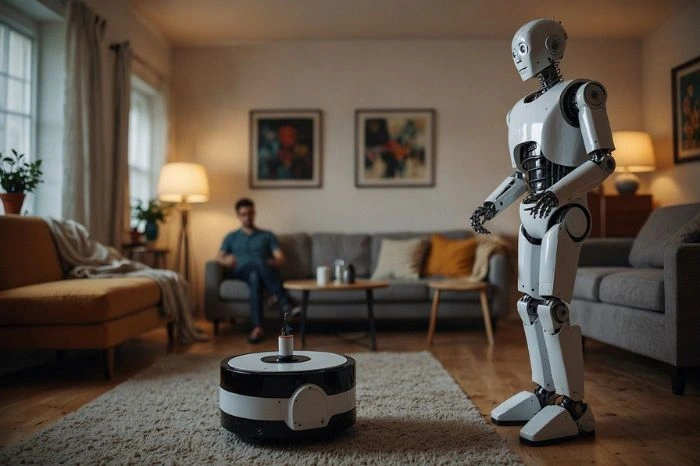When most people hear AI, they start picturing robots from sci-fi movies or complex tech built for computer geniuses. But the truth is that AI is already everywhere. In fact, a survey discovered that virtually all Americans utilize AI-enabled products, but around 64% of them have no idea. Learning how to ask AI the right way can actually make these tools even more helpful in daily life. There are chances that you have used it today without even noticing. From asking SIRI for directions to getting a Netflix suggestion that feels spot on, AI is working behind the scenes and showing up in life-changing gadgets that make everyday tasks easier.
Just think of it, your email inbox stays clean due to AI spam filters. Spotify just makes your playlist that somehow matches your mood. Google Maps reroutes you when there are traffic jams. Online shopping sites recommend products you didn’t even know you needed. Even food delivery apps use AI to predict what you are craving through your searches.
This article unpacks the everyday ways AI quietly makes life smoother, from our phones to our entertainment to our shopping habits, and what that means for the future, especially as companies like xAI expand their reach with bold AI initiatives.
Defining Artificial Intelligence
This branch of computer science mimics human thought processes and decision-making through algorithms. AI has various branches that perform a range of tasks. Some handle simple jobs, while others are far more intricate. Certain AI systems modify their own algorithms, and some are so advanced that they can outperform human experts in specific areas.
Machine learning and the Internet of Things are two key technologies transforming the future. ML enables machines to learn from data and improve over time, making them better at predictions and decisions without human input. It powers applications like autonomous vehicles, recommendation systems, and customer support by allowing devices to adapt to user needs.
IoT refers to a network of connected devices that use sensors to communicate and share data online. Commonly seen in smart homes, IoT devices like thermostats and speakers rely on ML, cloud computing, and natural language processing to respond to human interactions. However, IoT’s reach extends beyond homes to industries like healthcare, manufacturing, and entertainment.
Together, ML and IoT are revolutionizing how we interact with technology. IoT connects smart devices, while ML makes them more responsive, creating a future where technology effortlessly adapts to our needs.
5 AI Examples In Everyday Life Transforming Our World
1. Virtual Voice Helpers

Remember that time you were totally lost on a road trip, desperately asking Siri for directions while everyone in the car couldn’t stop laughing? Or when Alexa quietly told your potted plant the weather forecast for your beach getaway, just to surprise you later?
Unlike the annoying Meta AI on Facebook, which can feel intrusive with its unsolicited suggestions, these digital voice assistants grow smarter and feel like quirky companions rather than mere devices. They catch onto our sarcasm, adjust to our habits, and even throw in a joke now and then. These little moments of unexpected interaction in the middle of our everyday tasks remind us that technology, at its best, isn’t just useful! It can be pretty fun too.
2. E-Commerce

This is likely one of the most subtle ways people interact with AI in their everyday lives. Many online shopping and e-commerce platforms leverage AI to improve the customer experience in several ways. As a customer, AI might be present in:
- Tailored product recommendations based on past purchases or your customer profile.
- Dynamic pricing adjustments depending on supply, demand, or your previous shopping habits.
- Chatbots that offer quick responses to customer service or technical support inquiries.
- Estimating shipping times and possible delays.
As a business owner, you could implement AI in your applications to leverage its power in additional ways such as:
- Predicting sales and demand to better manage inventory with changing demand.
- Developing customer profiles and segmenting them to increase sales.
- Using smart analytics to track your business performance in real time.
3. GPS And Directions

AI has impacted the way we travel in a very extensive way. Instead of losing yourself by following the written maps or papers now, you just type your destination on the Google or Apple Maps application.
But how does the application determine your next destination? And beyond that, how does it know where it needs to go, where the sidewalks or crossings are, or even existing road construction, and traffic? While not too long ago GPS used satellites as the sole means, today navigation apps are using AI to improve the experience many times over.
Through machine learning, the algorithms draw out the learned features of buildings to enhance map looks and aid in the determination of house and building numbers. It also has a feature that includes changes in traffic and can therefore give directions that exclude traffic jams and congested areas.
4. Open AI

OpenAI became a major force in the AI space after introducing ChatGPT. The chatbot serves as a collaborative assistant for tackling complex queries, coding tasks, and web searches. ChatGPT saw a significant boost with the GPT-4o model, which can handle text, audio, images, and videos. OpenAI is further improving its models’ reasoning abilities with the OpenAI o1 model.
Here are the top 5 uses of ChatGPT:
- Customer Support: The platform handles customer queries, resolves issues, and offers 24-7 support, answering FAQs, and guiding users through processes.
- Content Creation: It assists writers with generating blogs, articles, product descriptions, and creative pieces like stories or poems. Businesses use it for marketing drafts, social media posts, and more.
- Education and Tutoring: ChatGPT aids students by explaining difficult subjects, providing tutoring, answering questions, and offering study tips or writing help.
- Programming Assistance: Developers rely on ChatGPT to write, debug, and explain code across various languages, making it an essential tool for learning and troubleshooting.
- Language Translation: ChatGPT translates text between languages, facilitating communication for individuals and businesses in multilingual settings. It also aids language learning through grammar explanations and conversation practice.
While OpenAI has made significant strides with ChatGPT, China is also making waves in AI innovation, competing on a global scale with its advancements in AI-driven industries.
5. Marketing and Promotions

Artificial intelligence plays a growing role in advertising, though you may not always notice it right away. Whether it’s creating ads specifically tailored to a location or age group or even writing the ad copy for you, AI is making waves in this area of marketing.
AI intelligence in advertising are evident: AI-driven tools streamline ad creation and optimize budgets, but they can sometimes lead to overly automated campaigns that feel impersonal to consumers.
Some examples of AI technology in advertising include:
- Creating Ads: AI tools can now design the whole ad. They can generate text and images from how customers interact with a product or from past sales data.
- Dynamic Ads: Platforms today allow companies to make ads that switch up the text or visuals depending on who’s looking, making it more personalized by focusing on factors like age or where someone lives.
- Budget Use: AI also helps decide how much to spend on certain ads. It directs funds toward those ads that seem to do the best, saving money by picking the right time or day.
Conclusion
And the next time you say that AI feels futuristic, take a pause and glance around. You are probably already using one. AI is not sci-fi or magic. It is making the drudgery of daily life not such a bother anymore. And seeing how it operates in our lives today provides us with a front row seat to where it’s going next, knowing also that risks like AI scams are real, so staying cautious matters.



